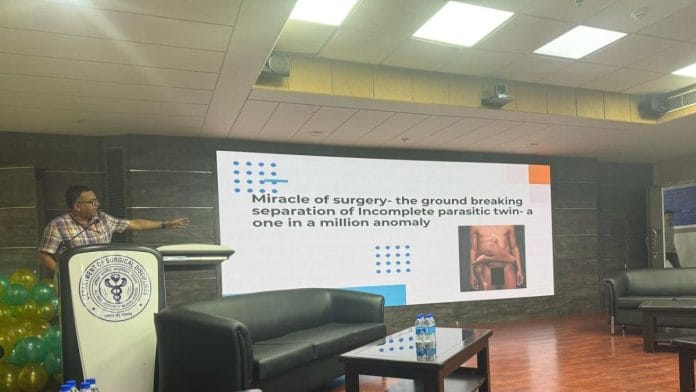New Delhi: In a rare and complex surgery, a team of doctors at AIIMS-Delhi successfully separated a parasitic twin from a 16-year-old boy—one of only 40 such cases ever recorded.
In extremely rare cases—rarer than conjoined twins—one twin fails to fully develop, leaving only a part of it behind. This remnant, known as a parasitic twin, remains attached to and dependent on the surviving twin, or the host.
Over time, this can lead to serious health complications for the host.
“The parasitic twin derives its nutrition and blood supply from the host,” Dr Asuri Krishna, additional professor at the Department of Surgical Disciplines, AIIMS-Delhi, explained at a press conference in New Delhi Tuesday. As the child grows, this dependence can cause cardiovascular strain, neurological issues, and, in some cases, become life-threatening.
At the press conference, doctors at AIIMS revealed that the patient had been living, since birth, with a fully developed lower limb attached to his abdomen—part of his underdeveloped twin. The limb, which also had underdeveloped male genitalia, grew in proportion with him over the years.
The boy could feel touch, pain, and temperature in the parasitic limb because they were connected via a nerve. While he occasionally experienced a dull ache in his abdomen and flank, his bowel and bladder functions remained normal, and he had no major health issues.
One of the biggest challenges in managing this case was understanding the parasitic twin’s blood supply, doctors said. Since the extra limb was well-formed, they needed to determine its source of blood flow and whether it was connected to any major abdominal organs like the liver, stomach, or intestines, which could have made the surgery even more complex.
“For this, we took the help of the radiology team,” said Dr Krishna. A computed tomography (CT) scan revealed that the parasitic twin was receiving blood from the internal mammary artery in the chest.
The scan also uncovered two large cysts inside the boy’s abdomen. “It appeared that the main body of the parasitic twin was actually lying within the abdominal cavity,” Dr Krishna explained. Given the complexity of the case, a coordinated team effort was crucial for the surgery’s success.
The multidisciplinary team at AIIMS, led by Dr Krishna, included Dr VK Bansal, Dr Sushant Soren, Dr Brijesh Kumar Singh, Dr Abhinav Kumar, and Dr Jaymeen Makwana from the Department of Surgical Disciplines; Dr Manish Singhal and Dr Sashank from the Department of Plastic Surgery; Dr Ganga Prasad and Dr Rakesh from the Department of Anesthesia; and Dr Atin and Dr Ankita from the Department of Radiology.
The doctors successfully removed the extra limb along with the two large cysts without causing any internal injury. The boy was kept in the ICU for 24 hours post surgery and discharged four days later.
Doctors noted that the success rate for such surgeries is “good” when the condition is detected early. “Most cases are identified either at birth or by the age of five to seven,” said Dr Krishna. “It has been nearly 15 years since a case like this has been reported, as it is extremely rare for someone to remain undiagnosed until 16 years of age.”
The boy from Unnao had to drop out of school due to the social challenges posed by his condition. His family’s socio-economic constraints also played a role in the delayed diagnosis, as they were unaware that his condition was treatable until they eventually reached AIIMS.
“In many remote areas, prenatal screenings are either unavailable or people simply don’t know about them,” said one of the doctors. “This lack of awareness is a major reason why such cases go undetected in the early stages.”
(Edited by Radifah Kabir)
Also Read: Posture panic hits researchers. IITs, AIIMS, big hospitals use smart microscopes now






